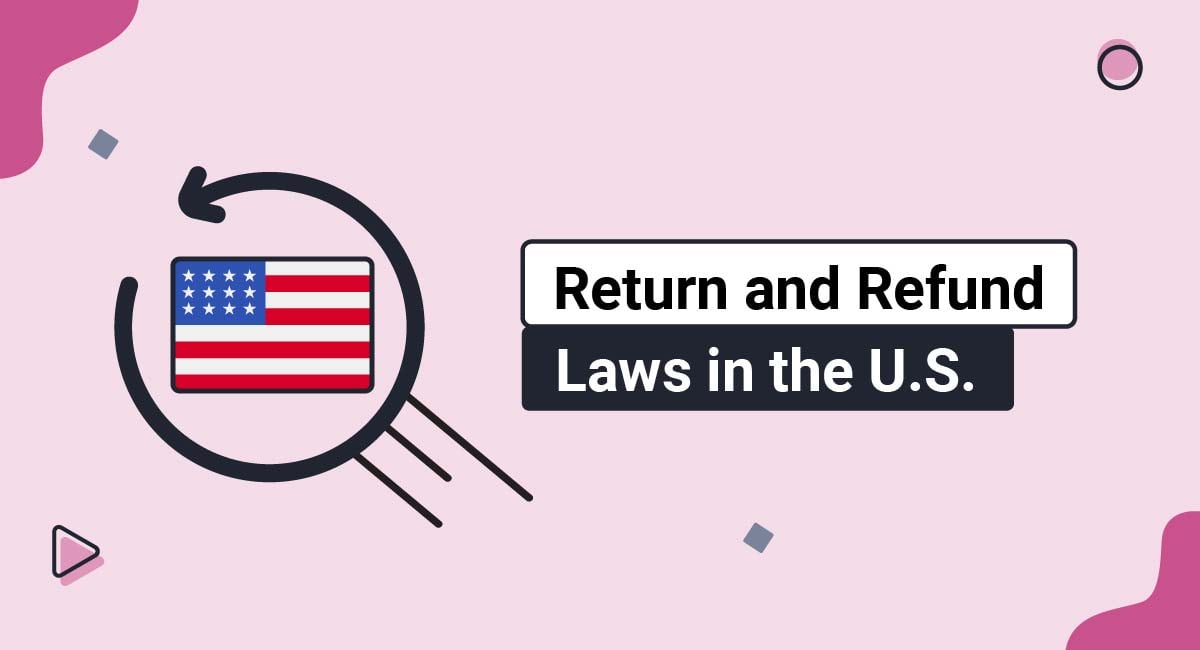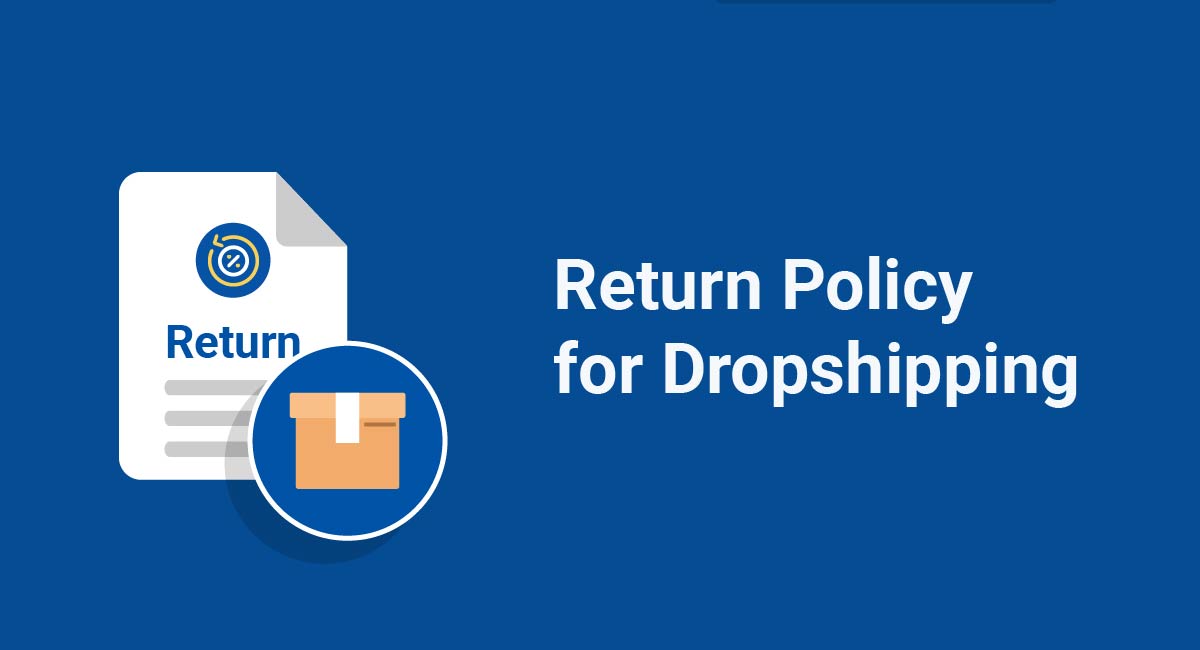While the U.S. does not have federal laws affecting returns and refunds, it's still a good idea to have a Return & Refund Policy, and it will be required in some states if you wish to have control over the terms of your policy.
U.S. state laws do not require a Return & Refund Policy either but under certain circumstances, you will need to post this policy conspicuously in your storefront or through your ecommerce website.
Issuing returns and refunds is at your store discretion. However, informing of your policies and maintaining fair terms is expected from your customers.
This article will provide an overview of the laws affecting your Return & Refund Policy in the U.S. and look at some best practices for allowing returns, refunds, and exchanges for merchandise.
Use our Return & Refund Policy Generator to generate a Return and Refund Policy for your store. Just follow these steps:
-
At Step 1, select where your Return & Refund Policy will be used.
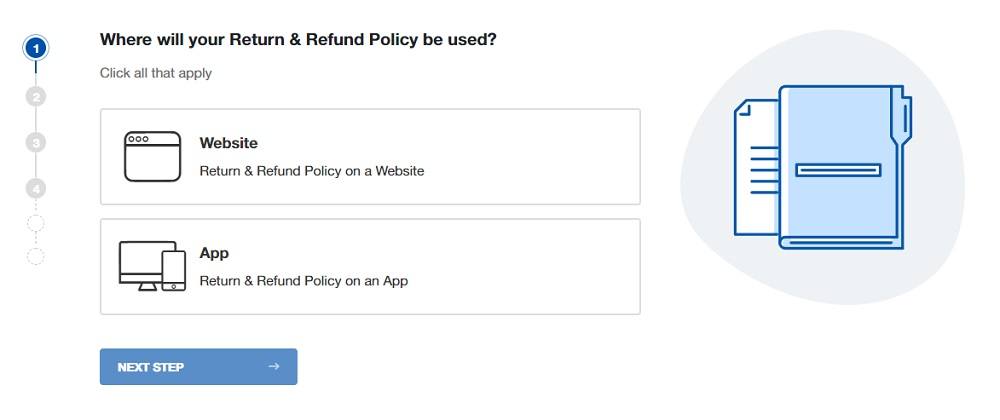
-
At Step 2, add information about your website/app and business.
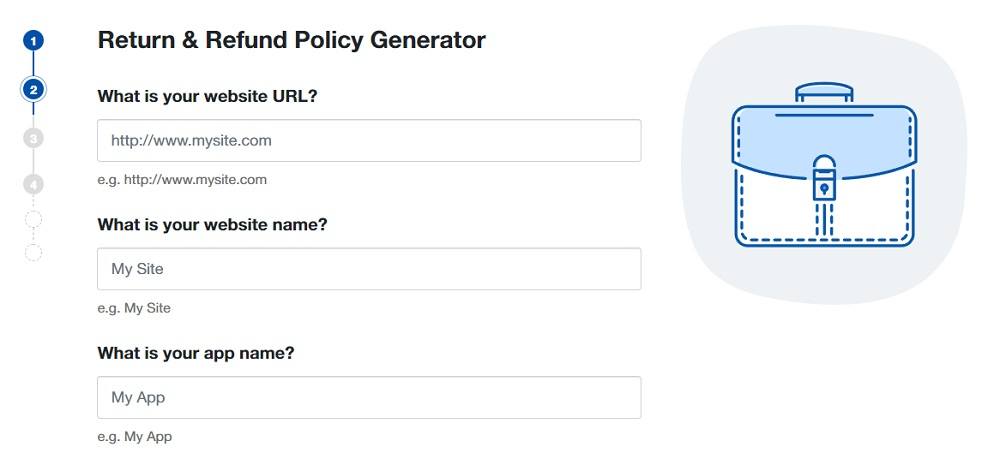
-
Answer some questions about your business practices.
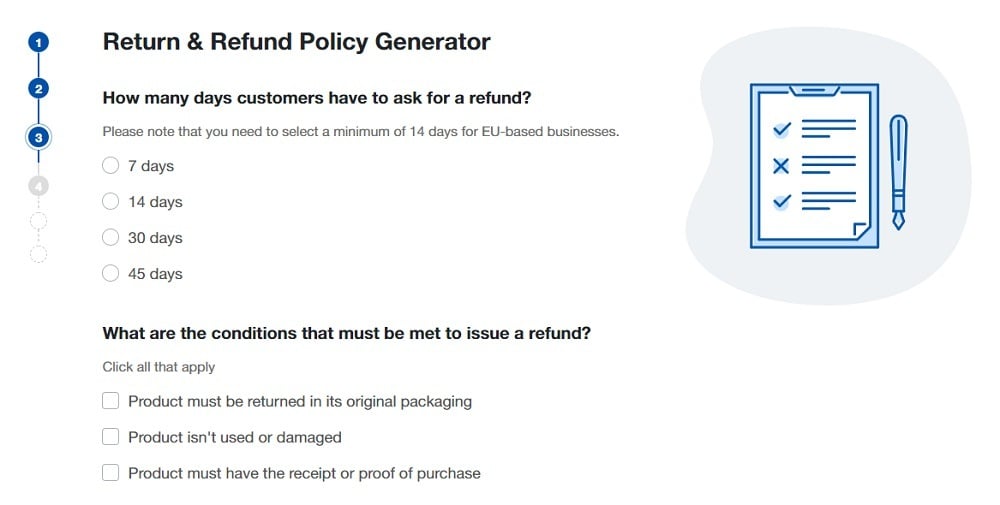
-
Enter an email address where you'd like to receive your Return and Refund Policy and click "Generate."
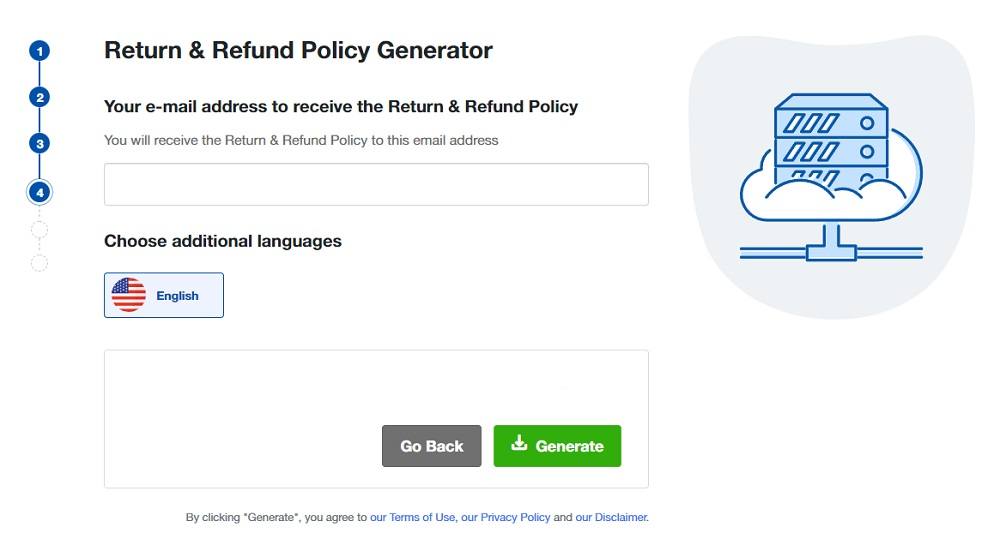
Done! You'll be able to instantly access and download your new Return and Refund Policy.
- 1. What is a Return & Refund Policy
- 2. Return & Refund Laws by State
- 2.1. California Return & Refund Policy Laws
- 2.2. Connecticut Return & Refund Policy Laws
- 2.3. Florida Return & Refund Policy Laws
- 2.4. Hawaii Return & Refund Policy Laws
- 2.5. Illinois Return & Refund Policy Laws
- 2.6. Maryland Return & Refund Policy Laws
- 2.7. Massachusetts Return & Refund Policy Laws
- 2.8. Minnesota Return & Refund Policy Laws
- 2.9. New Jersey Return & Refund Policy Laws
- 2.10. New York Return & Refund Policy Laws
- 2.11. Ohio Return & Refund Policy Laws
- 2.12. Rhode Island Return & Refund Policy Laws
- 2.13. Virginia Return & Refund Policy Laws
- 3. What to Add In U.S. Return & Refund Policies
- 3.1. Cost of Return
- 3.2. Timeframe of Allowed Returns
- 3.3. Form of Refund
- 3.4. Return Conditions and Requirements
- 3.5. Case-by-Case Refunds
What is a Return & Refund Policy
A Return & Refund Policy is a policy that informs customers of the cost, timeframe, and requirements for returning merchandise for a refund or exchange.
This policy also indicates whether a refund is provided as store credit or return of the purchase price. If there are conditions to securing a return, refund or exchange, the Return & Refund Policy lists those as well.
A Return & Refund Policy may be included within a Terms & Conditions agreement or be its own fully separate document, occupying its own page on your website.
Retailers also often provide this policy in hard copy with shipments. Most retailers provide the Return & Refund Policy online in FAQ format and in the Terms & Conditions agreement itself.
Stores may create as generous or restrictive of a Return & Refund Policy as they see fit for their business.
Amazon has a generous Return & Refund Policy that varies based on merchandise type and covers a wide range of items. You can see this in the Table of Contents section of the policy:
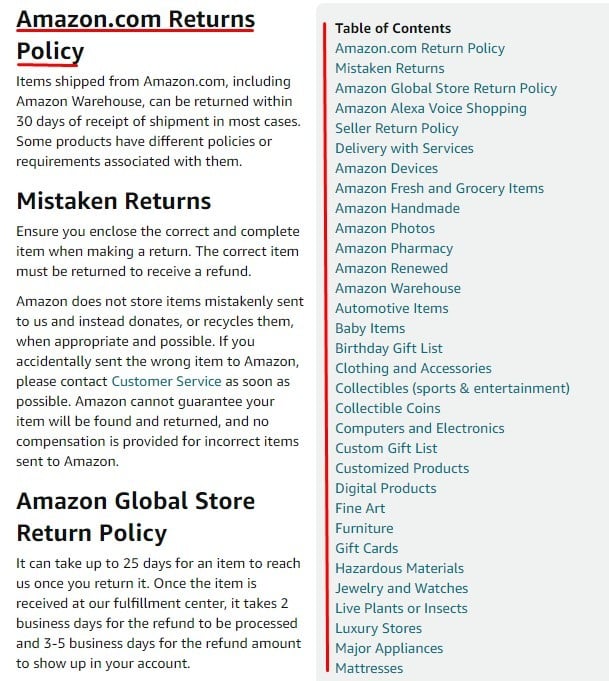
Amazon also incorporates the Return & Refund Policy in its "Conditions of Use" agreement. This is a brief mention that includes a link to the Return & Refund Policy:

Smaller retailers also take this approach.
thredUP, a used clothing exchange and sales site headquartered in California, includes its Return & Refund Policy in its Terms of Use agreement and in a separate Support Section on returns.
This is how thredUP presents its policy on returns in the Terms of Use agreement:
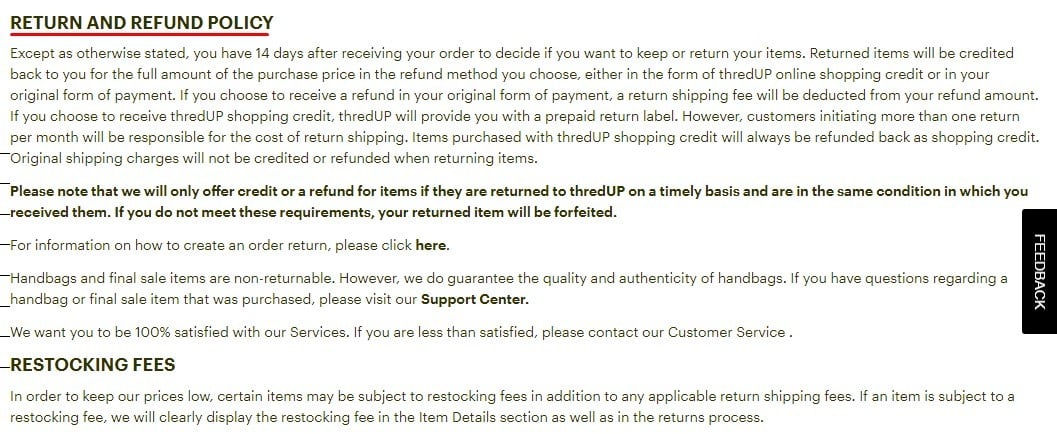
This is the summarized support version of its Return & Refund Policy:
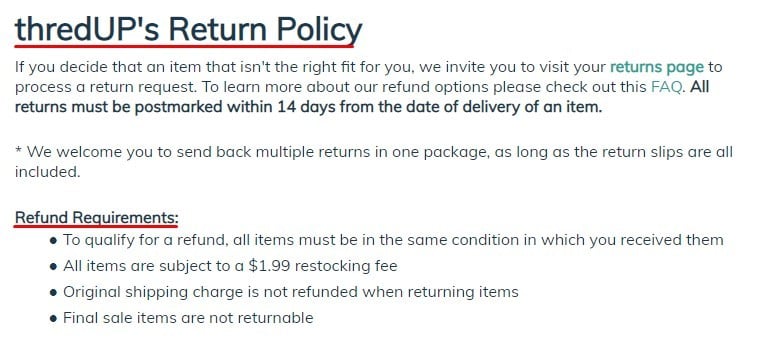
Return & Refund Laws by State
A number of states have passed laws regarding Return & Refund Policies. Some of them are limited to the cancellation of transactions, like hotel or campsite reservations and digital products. Others are primarily focused on assuring consumers see the policy on a website or in a store.
While no state laws truly require a Return & Refund Policy, there are circumstances where you need to make your Return & Refund Policy conspicuous at your storefront and on your website. Each law has guidelines on making this happen.
The following list includes fourteen states with laws affecting Return & Refund Policies and their requirements.
California Return & Refund Policy Laws
Civil Code Section 1723 of the California state requires a retailer to post their Refund Policy if the policy contains unique requirements. For example, requirements that wouldn't be expected by an average consumer.
Common expectations in the U.S. for retailers' offerings include:
- A full cash or credit refund
- An exchange
- Or a combination of these solutions when buyers are unsatisfied with their purchase
If the Return & Refund Policy does not include these expectations, it must be conspicuously displayed, even it only applies to one class of merchandise.
For example, if a retailer only authorizes exchanges but not refunds, that would need to be displayed.
Likewise, if returns are not authorized on particular merchandise, like medical items, that must also be displayed.
If the display of the policy is necessary, the Return & Refund Policy must state:
- Whether a cash refund, store credit or exchange is given for the full purchase price
- The time period a refund, credit or exchange is authorized
- Merchandise covered by the policy, and
- Conditions for a refund, credit or exchange. For example, that is must have the receipt and original packaging
Exceptions to this policy include perishable items, merchandise marked "as is," goods damaged after purchase, customized goods that meet specifications, merchandise without its original packaging, and exchanges that cannot be made due to public health reasons.
Connecticut Return & Refund Policy Laws
Connecticut law allows retailers to set their own Return & Refund Policy terms. The only requirement is that they display the policy in a conspicuous place.
If the Return & Refund Policy is not displayed or the retailer does not have a Return & Refund Policy, the buyer is entitled to a refund in the amount of the purchase price.
Retailers are not obligated to provide a refund without proof of purchase.
Connecticut law does not apply to perishable items, plants, custom-made goods, used items, and those that cannot be resold due to state regulations.
Merchandise marked "as-is" or "final sale" also fall under these exceptions.
Florida Return & Refund Policy Laws
The law in Florida only concerns retailers who will not issue refunds. If your store policy is a "no refunds" policy, Florida statutes require you to clearly state this conspicuously near store entrances or the cashier's station.
If you do not post a Return Policy informing customers of your "no refunds" policy, customers are entitled to a full refund if they make returns within 7 days of purchase.
Hawaii Return & Refund Policy Laws
Retailers in Hawaii can have one of four different return policies:
- Refunds only,
- Refunds or merchandise credit only,
- Exchanges or merchandise credit only, or
- No refunds, merchandise credit or exchanges
The retailer must conspicuously post its policy.
Any return window that's less than 60 days must be noted, as well as any categories of goods that are excluded from the policy, such as final sale or clearance items.
If store credit is offered and a customer can't find a suitable substitute to use the credit on within 30 days, the customer can get a cash refund unless there was a conspicuous notice stating that credit cannot be converted into cash. Any store credit must be valid for at least 2 years.
If a Refund Policy is not conspicuously posted, the business must offer a refund for any goods returned within 60 days of purchase.
Illinois Return & Refund Policy Laws
Returns & Refunds Policies in the state of Illinois are up to retailers and the law makes no requirements for these policies.
The right to cancel a transaction is only available with door-to-door sales for more than $25, campground memberships, and fitness centers.
Maryland Return & Refund Policy Laws
Maryland law requires retailers to post their Return & Refund Policy on the storefront wall, merchandise or the receipt. Stores can refuse returns if it is specifically stated in the policy.
Without a posted Returns & Refund Policy, retailers in Maryland must accept returns if they are submitted within a reasonable time period.
Defective merchandise must be repaired, replaced, or refunded.
Massachusetts Return & Refund Policy Laws
Massachusetts retailers must disclose their refund, return or exchange policy before finishing a transaction with a buyer. This is normally done with a conspicuous sign.
Without a Return & Refund Policy, retailers in Massachusetts must accept all returns submitted within a reasonable period after purchase.
Minnesota Return & Refund Policy Laws
Minnesota statutes require a retailer to conspicuously display its Return & Refund Policy in boldface type set at a minimum of 14 points.
If the Return & Refund Policy is not posted or fails this standard, the retailer must accept all returns and issue full refunds.
New Jersey Return & Refund Policy Laws
New Jersey retailers must post their Return & Refund Policy conspicuously.
If one is not posted, then the retailer must allow returns, issue refunds or provide store credit for any merchandise submitted within 20 days of purchase.
The policy must contain certain specific information such as whether refunds will be given for items without a proof of purchase, products returned after a particular period of time, and products sold "as is" or on sale. It must make it clear how refunds will be issued (cash, store credit, etc.).
New York Return & Refund Policy Laws
Every New York retailer must conspicuously post its Return & Refund Policy.
If a retailer from New York does not provide a Return & Refund Policy, then the retailer is required to accept returns and issue refunds for all merchandise submitted within 30 days of purchase.
Other than this notice requirement, there is no law requiring retailers to offer refunds or replacement merchandise. However, if a retailer has this policy, it must post it or it is not enforceable.
Ohio Return & Refund Policy Laws
Retailers in Ohio are not required to have a Return & Refund Policy. If the retailer has a Returns & Refunds Policy, it must be conspicuously posted.
Putting the Return & Refund Policy on the receipt is not considered adequate because customers only see it after completing the purchase.
Without a posted Refund Policy, retailers in Ohio must accept returns and issue refunds. Restocking fees can be included with the cost of the return, but that must be posted where customers can see it.
Rhode Island Return & Refund Policy Laws
Return & Refund Policies in Rhode Island must be conspicuously posted as a sign or poster at the cash register or store entrance. This is especially true if all sales are considered final and goods are not returnable.
If there is no Return & Refund Policy posted, customers can return merchandise for a refund within 10 days of purchase.
Virginia Return & Refund Policy Laws
Virginia code requires businesses to conspicuously post its policy or customers can return items within 20 days of purchase.
What to Add In U.S. Return & Refund Policies
Most online Return & Refund Policies contain information about return costs, timeframes when returns are allowed, how you issue refunds, and any additional conditions you impose.
Let's take a look at each in turn.
Cost of Return
The cost of return includes return shipping paid by the buyer or restocking fees. Since customers do not like surprises on costs, make these conspicuous in your Return & Refund Policy.
If it's just one fee, like a restocking or processing fee, make it stand out with a star or bold print. Bold print, shaded boxes, and other embellishment can make these fees or costs more obvious.
Dyers charges a restocking/handling fee of up to 15% on returns of items purchased during free shipping promotions or sold with reduced flat rate shipping costs. Not only does it note this, but it also goes a bit into why this is the case. This can help a lot with customer expectations and feeling like you aren't just trying to keep their money with no explanation:
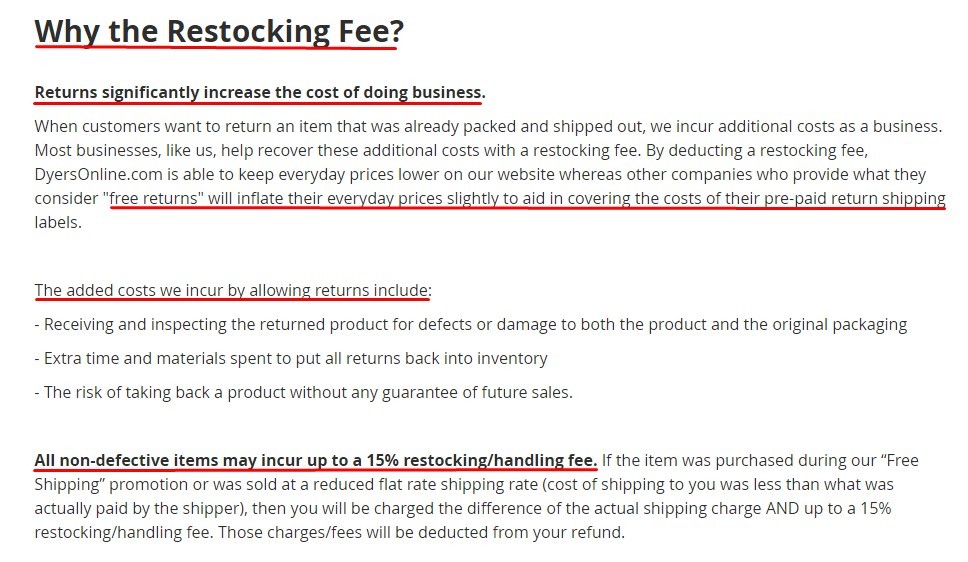
Timeframe of Allowed Returns
Disclose what your timeframe is where customers can return items. Without this, your business will be open to having to accept returns well into the future and this may invite fraud.
Wardrobe fraud, the practice of buying clothes, wearing them, and then returning them while claiming they were never worn, is one danger.
Also, you may have customers who use software, play video games, and treat your Return Policy as a free exchange. You can avoid these scenarios with timeframes.
Limiting returns to a timeframe protects your business interests.
Dyers has a standard 30 day timeframe for returns, but also notes that some items are not returnable at all, while others have only a 10 day window:
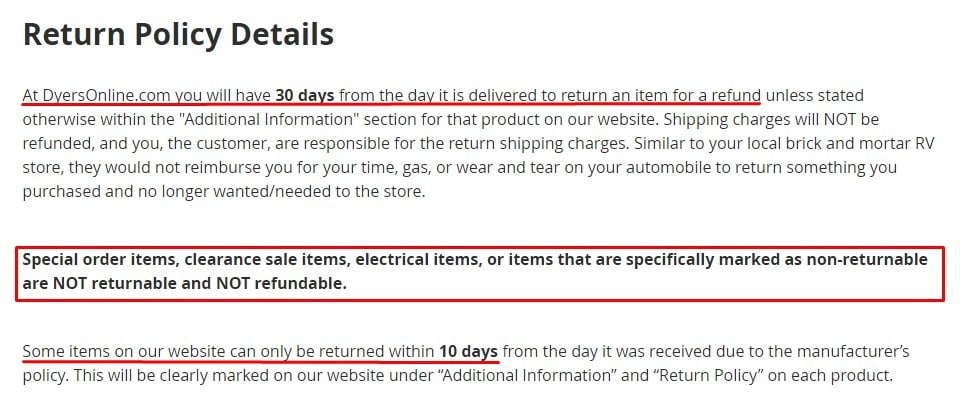
Larger retailers that trade in many products may assign a timeframe for each class of product.
Best Buy offers timelines based on type of merchandise and presents them in an easily read table. It also extends return privileges to customers who invest in an "Elite." "Elite Plus" or "Totaltech" memberships:
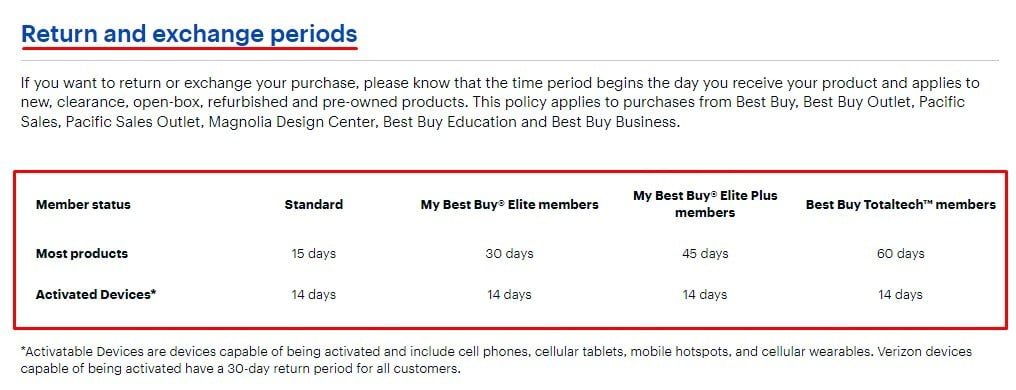
As mentioned, there are no federal laws controlling timeframes.
However, state laws as listed above impose minimums that range from 10 days up to 60 days.
These only apply if no Return Policy is provided, so if you place your timeframes in a conspicuous place on your website, you can set them to any limits you consider reasonable.
Form of Refund
The form of refund section of a Return Policy informs customers whether they receive store credit, a cash refund or some other method of refund when they return merchandise. This can vary based on circumstances.
Best Buy notes that the method of refund will be in the same method the payment was originally made, in most cases. It also lists some specifics, such as what happens if a person paid more than $800 in cash or more than $250 by check, and how gift card balance refunds will be issued:

You can also offer a replacement for damaged items along with or instead of a refund.
Your store has the option of offering refunds, store credit or an exchange based on circumstances or you can have a universal policy that only gives store credit or cash refunds.
As long as you make it clear to your customers, your decision is acceptable under U.S. law.
Return Conditions and Requirements
You may have conditions for accepting returns or issuing a refund. No laws prevent you from doing that.
A common condition for a successful return is the item still having its original packaging or tags. Conditions may depend on type of merchandise.
Best Buy has a "Special Considerations" clause in its Return and Exchange Policy that discusses conditions of return on a number of different categories of merchandise:
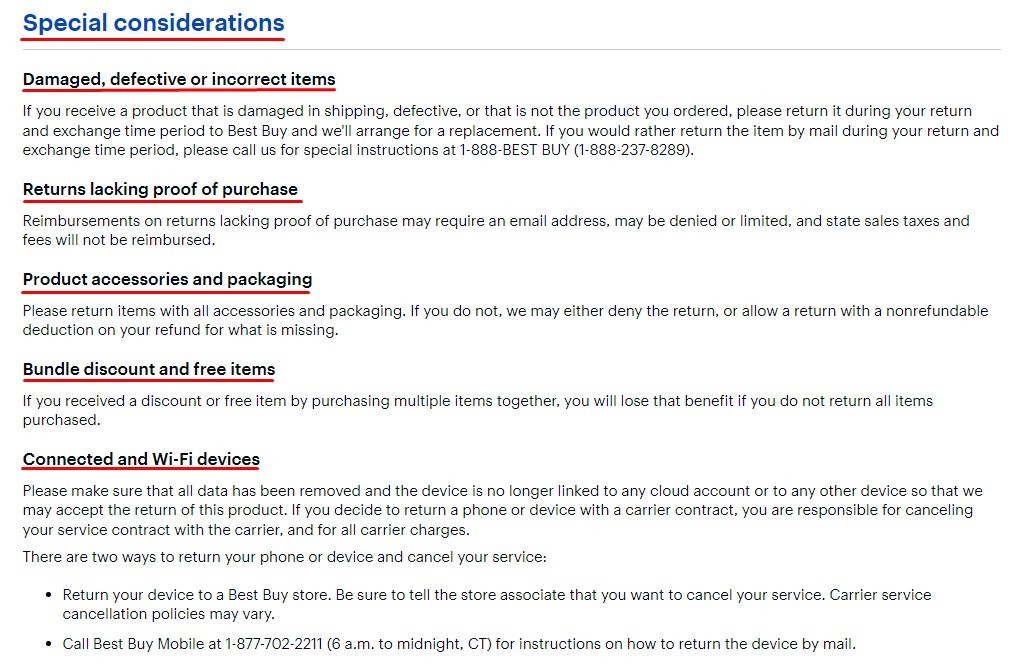
For example, items that come with accessories and packaging must be returned with both or the return may be denied or have a fee deducted. If a return doesn't have a proof of purchase, state sales taxes and fees may not be reimbursed. If you return a wifi device and don't remember to cancel the contract for the service, you are responsible for the charges on the service still.
Return conditions are easy to set in your Return & Refund Policy if you only sell one type of merchandise.
If you deal with several types, consider their elements thoroughly so any conditions or timeframes you place on your customers are reasonable.
Case-by-Case Refunds
If you accept or limit certain refunds on an individually-determined basis, disclose this and what your parameters are for accepting or rejecting a return request.
Digital products offer challenges. It's possible for users to download a product, claim it does not meet expectations, and then demand a return and refund - while still using the product.
There is no material product to verify a return and issuing refunds without investigation can lead to abuse.
A Return & Refund Policy with the elements above is not as helpful for these products. Rather than maintain a full policy, companies dealing with digital products often issue refunds on a case-by-case basis.
If a refund request is rare and the possibility of technical failure is likely, it's likely the company issues the refund.
However, if a particular customer makes repeated requests and it's not possible for products to fail that frequently, it will suspect fraud and not issue the refund.
This is how Apple handles these requests, explaining that it reserves the right to refuse a refund request if there's any evidence of fraud:
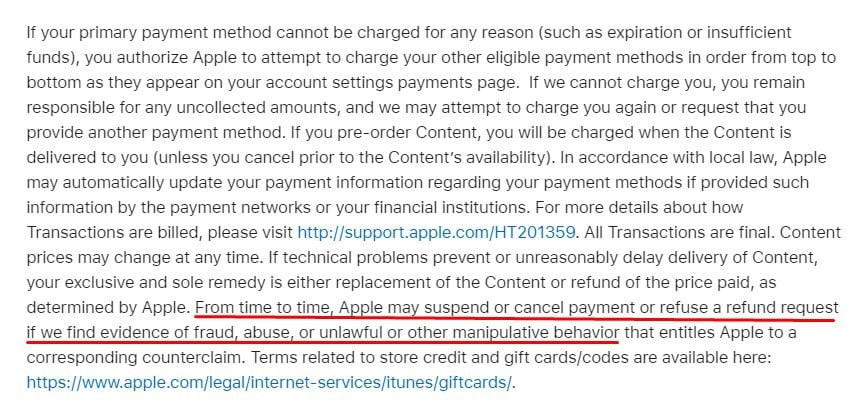
You may also want to take these matters on a case-by-case basis and state that in a Return & Refund Policy or in your Terms & Conditions agreement.
While a Return & Refund Policy may not be required, Americans expect retailers to accommodate returns and refunds. Offer clear terms that include what you will not authorize.
That keeps you in compliance with state laws but it also enhances goodwill among your customers.

Comprehensive compliance starts with a Privacy Policy.
Comply with the law with our agreements, policies, and consent banners. Everything is included.
